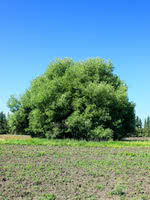Mon-Fri 9am - 5pm Mountain time
Common Hackberry vs Acute Willow
Celtis occidentalis
Salix acutifolia
The Common Hackberry is a medium-sized deciduous tree that resembles the American Elm but is immune to Dutch Elm Disease. They are versatile and can adapt to a variety of growing conditions.
It produces purple-red, berry-like fruit with a large seed in the center. Both the sweet flesh, which tastes similar to dates, and the crunchy seed are edible. The fruit remains on the tree throughout the winter, offering a valuable food source for birds and other wildlife.
The Common Hackberry can also be a great addition to a pollinator garden. The tree itself is a host for the larvae of several butterfly species and the flowers provide a source of pollen and nectar.
Acute Willow is a very fast growing small tree that can reach growth rates of up to 6 feet per year. It's a great choice for developing a quick, hardy shelterbelt, windbreak, or privacy screen.
Acute Willow will grow multi-stemmed but can be pruned to a single stem for a smaller footprint. It prefers moist areas and requires almost no maintenance.
Willows are important to native pollinators each spring as they have higher amounts of pollen and nectar early each growing season when other food sources are scarce.
Common Hackberry Quick Facts
Acute Willow Quick Facts
In row spacing: 2.4 m (8 ft)

